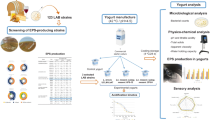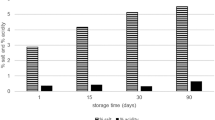Abstract
A method has been developed for producing analogs of fermented milk drinks from pumpkin seed meal, which is a massive waste product from oilseed production, using new strains of lactic acid bacteria (LAB) isolated from different samples of kumiss. Based on the results of screening 50 LAB isolates capable of fermenting milk and aqueous meal extracts in a wide pH range, three strains with the best growth characteristics were selected. These strains were identified as representatives of the genus Lacticaseibacillus, most closely related to L. rhamnosus and L. casei (with 99.93 and 99.65% similarity in 16S rRNA gene sequences). An optimal scheme for producing drinks has been selected, including grinding meal, optimized extraction with alkaline solutions, heat treatment of the extract to remove foreign microflora, introduction of the inoculum (3–5% vol/vol) of new LAB strains, and fermentation at 37oС for ten hours. Compared with the fermented milk product obtained by fermenting milk with the same microorganisms, the drink made from meal extracts was distinguished by the absence of lactose and cholesterol, and increased content of unsaturated fatty acids (2.3 times) and protein (1.7 times), and the presence of essential amino acids in proteins. Thus, pumpkin seed meal, which is still used ineffectively, is a good basis for obtaining analogs of fermented milk products with beneficial properties. The developed method for producing lacto-fermented drinks can be adapted for processing other types of meals and cakes.



Similar content being viewed by others
REFERENCES
Silva, A.R., Silva, M.M., and Ribeiro, B.D., Food Res. Int., 2020, vol. 131, no. 1, p. 108972. https://doi.org/10.1016/j.foodres.2019.108972
Vanga, S.K. and Raghavan, V., J. Food Sci. Technol., 2018, vol. 55, no. 1, pp. 10–20.
Kundu, P., Dhankhar, J., and Sharma, A., Curr. Res. Nutr. Food Sci. J., 2018, vol. 6, no. 1, pp. 203–210.
Mortas, M., Besir, A., Tok, Z., Keles, M., and Yazici, F., Plant Foods Hum. Nutr., 2023, vol. 78, pp. 358–365.
Bastıoğlu, A.Z., Tomruk, D., Koç, M., and Ertekin, F.K., J. Food Sci. Technol., 2016, vol. 53, no. 5, pp. 2396–2404.
Makinen, O.E., Wanhalinna, V., Zannini, E., and Arendt, E.K., Crit. Rev. Food Sci. Nutr., 2016, vol. 56, no. 3, pp. P. 339–349.
Ma, W., Zhang, C., Kong, X., Li, X., Chen, Y., and Hua, Y., Food Biosci., A, 2021, vol. 44, p. 101416. https://doi.org/10.1016/j.fbio.2021.101416
Ahmadian-Kouchaksaraei, Z., Mohammad, M.V., Varidi, J., and Pourazarang, H., LWT—Food Sci. Technol., 2014, vol. 57, no. 1, pp. 299–305.
Hickisch, A., Beer, R., Vogel, R.F., and Toelstede, S., Food Res. Int., vol. 84, pp. 180–188.
Garro, M.S., de Valdez, G.F., and de Giori, G.S., Food Microbiol., vol. 21, no. 5, pp. 511–518.
Vlaicu, P.A. and Panaite, T.D., Anim. Biosci., 2022, vol. 35, no. 2, pp. 236–246.
Valdez-Arjona, L.P. and Ramirez-Mella, M., Animals (Basel), 2019, vol. 9, no. 10, p. 769. https://doi.org/10.3390/ani9100769
Ulanova, R. and Kravchenko, I., Int. J. Eng. Sci. Innov. Technol., 2013, vol. 2, no. 6, pp. 618–624.
Ulanova, R.V., Kravchenko, I.K., Gorelova, O.P., and Nikolaeva, O.S., RF Patent No. 2557404, 2015.
Afzaal, M., Saeed, F., Anjum, F., Waris, N., Husaain, M., Ikram, A., et al., Food Sci. Nutr., 2021, vol. 9, no. 11, pp. 6421–6428.
Tang, H., Ma, H., Hou, Q., Li, W., Xu, H., Liu, W., and Menghe, B., BMC Microbiol., 2020, vol. 20, no. 1, pp. 1–11.
Meng, Y., Chen, X., Sun, Z., Li, Y., Chen, D., Fang, S., and Chen, J., LWT, 2021, vol. 135, p. 110049. https://doi.org/10.1016/j.lwt.2020.110049
Filippova, S.N., Surgucheva, N.A., Kolganova, T.V., Cherbunina, M.Yu., Brushkov, A.V., Mulyukin, A.L., and Gal’chenko, V.F., Biol. Bull. (Moscow), 2019, vol. 46, no. 3, pp. 234–241.
Ostroumov, L.A. and Gavrilov, V.G., Biotransformation of lactose by β-galactosidase enzyme preparations, Tekhn. Tekhnol. Pishch. Proizv., 2013, no. 1, pp. 26–30.
McCleary, B.V., J. AOAC Int., 2019, vol. 102, no. 1, pp. 196–207.
Zheng, J., Wittouck, S., Salvetti, E., Franz, C.M., Harris, H.M., Mattarelli, P., et al., Int. J. Syst. Evol. Microbiol., 2020, vol. 70, no. 4, pp. 2782–2858.
Śliżewska, K. and Chlebicz-Wójcik, A., Biology (Basel), 2020, vol. 9, no. 12, p. 423. https://doi.org/10.3390/biology9120423
Sawatari, Y. and Yokota, A., Appl. Environ. Microbiol., 2007, vol. 73, no. 12, pp. 3909–3915.
Kluczkovski, A., Lima, N., and Oliveira, M.K., J. Food Proc. Preserv., 2017, vol. 41, no. 5, p. 13147. https://doi.org/10.1111/jfpp.13147
Jiménez-Martínez, C., Hernández-Sánchez, H., and Dávila-Ortiz, G., J. Sci. Food Agricult., vol. 83, no. 6, pp. 515–522.
Ulanova, R.V., Nikolaev, Yu.A., Kolpakova, V.V., Galuza, O.A., and Sinel’nikov, A.V., RF Patent No. RU2784723.25, 2022.
Silva, D., Nunes, P., Melo, J., and Quintas, C., AIMS Microbiol., 2022, vol. 8, no. 1, pp. 42–52.
Shahein, M.R., Atwaa, E.S.H., Alrashdi, B.M., Ramadan, M.F., Abd El-Sattar, E.S., Siam, A.A.H., et al., Fermentation, 2022, vol. 8, no. 5, p. 223. https://doi.org/10.1016/j.fbio.2021.101416
Vlaicu, P.A. and Panaite, T.D., Anim. Biosci., 2022, vol. 35, no. 2, pp. 236–246.
Funding
This study was supported by the Ministry of Science and Higher Education of the Russian Federation within the framework of State Assignment no. 122040800164-6 of the Federal Research Center of Biotechnology, Russian Academy of Sciences, and Agreement no. 075-15-2021-1051.
Author information
Authors and Affiliations
Corresponding author
Ethics declarations
ETHICS APPROVAL AND CONSENT TO PARTICIPATE
This work does not contain any studies involving human or animal subjects.
CONFLICT OF INTEREST
The authors of this work declare that they have no conflicts of interest.
Additional information
Translated by V. Mittova
Publisher’s Note.
Pleiades Publishing remains neutral with regard to jurisdictional claims in published maps and institutional affiliations.
Rights and permissions
About this article
Cite this article
Sinelnikov, A.V., Kolganova, T.V. & Ulanova, R.V. Obtaining Analogues of Fermented Milk Products from Seed Meal Using New Strains of Lactic Acid Bacteria. Appl Biochem Microbiol 60, 476–482 (2024). https://doi.org/10.1134/S0003683824603664
Received:
Revised:
Accepted:
Published:
Issue Date:
DOI: https://doi.org/10.1134/S0003683824603664




